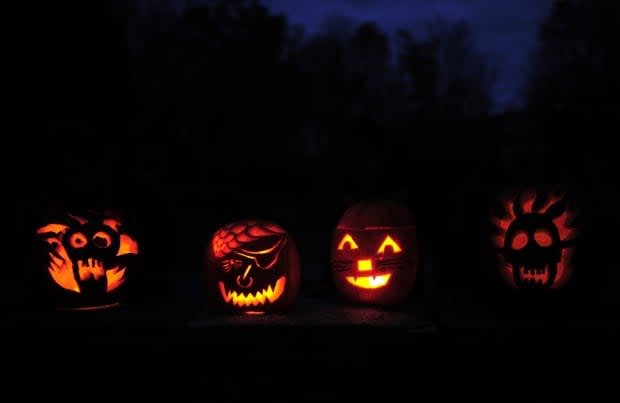How Did the Jack-O'-Lantern Become a Scary Halloween Staple?
- Oops!Something went wrong.Please try again later.
The history of jack-o'-lanterns and where Halloween pumpkins originated
Pumpkins are now one of most recognizable symbols of Halloween, but they weren’t used as jack-o’-lanterns until the mid-19th century. How did pumpkins go from being an ordinary squash to a Halloween staple?
In Pumpkin: The Curious History of An American Icon, Cindy Ott documents the surprising importance of pumpkins throughout American history, from their crucial role in early American agriculture to the symbolic part they play in some of our most beloved fall rituals. In the passage below, Ott explores the origins of the carved jack-o’-lantern, especially as it relates to the classic "Sleepy Hollow" legend:
Related: 24 Creative Jack-O-Lantern Ideas to Up Your Pumpkin Carving Game

EMMANUEL DUNAND / Staff
One of the best-known literary works in which a pumpkin stands in for a man’s foolishness is Washington Irving’s The Legend of Sleepy Hollow, published in 1848 and set in the rural countryside of New York’s Hudson River valley. As a central element of the tale, the pumpkin represents the area’s rusticity as well as the buffoonery of its main character, Ichabod Crane. In the story, Crane, a silly, gangly, itinerant schoolteacher, spends his idle hours spooking himself by reading local ghost stories, especially a notorious one about the Headless Horseman. According to the legend, the Horseman’s head was severed from his body during a Revolutionary War battle fought in the area, and he periodically rides again to reclaim it.
Related: 20 Creative Jack-O-Lantern Ideas
One night, while returning home late from a party down an isolated country road, Crane, who is afraid of his own shadow, is chased by the Headless Horseman. As the apparition rides past Crane, the ghost throws a headlike object at him, terrifying the schoolmaster so profoundly that he runs away and is never heard from again. The end of the tale reveals that the ghoul was actually Brom Bones, Ichabod’s rival for the attention of a farmer’s attractive young daughter. The head was nothing but a pumpkin, accentuating the Crane character’s silliness and perpetuating this age-old association.
About the time of the publication of Sleepy Hollow, the pumpkin first appeared in its incarnation as a jack-o’-lantern, although Halloween was not yet a part of Americans’ regular holiday calendar. The jack-o’-lantern as a folk character originated in Ireland as a trickster forced to wander the netherworld after being banned from both heaven and hell for his ornery behavior. He had nothing to do with the pumpkin at all. Americans may have merged the Irish jack-o’-lantern with legends about supernatural pumpkins, but another source lay closer to home.

In North America, “jack-o’-lantern” (or jack-ma-lantern among African Americans in the South) was another name for the will-o’-the-wisp—an unsettling and inexplicable light emanating from a darkened forest or dense swamp. A newspaper account published in October 1830 offers a good description: “Two gentlemen saw a globe of light or fire apparently twenty feet above the ground. The light resembled a large lamp, was in constant motion, slowly traveling on a light breeze...This is the first ‘Will with a Whisp,’ or Jack o’ Lantern, of which we have had any credible information for many years." Jack-o’-lantern personified the unknown, bewildering forces that seemingly occupied wild places. For some, it was not simply a spook. Like St. Pompion, it might lead people astray or lure them with its evil ways. “If the victim had an irresistible urge to follow the Jack-O’-Lantern,” explained one source, “it would be overcome only by ‘flinging [himself] down, shutting [his] eyes, holding [his] breath, and plugging up [his ears].’”
Related: 17 Creative DIY Halloween Costumes for Women
By having a ghost hurl a pumpkin from the dark and sinister woods, Irving combined the pumpkin and the jack-o’-lantern legends, but the pumpkin in his story was not carved into a grinning jack-o’-lantern. One of the earliest examples of the pumpkin as jack-o’-lantern is an 1846 newspaper account called “The Jack o’Lantern,” about a young boy taking a pumpkin that a farmer did not “make any use of” and carving in it “the outline of three faces, with their eyes, and noses, and teeth.” The article made no mention of Halloween, however, and the story’s description of a man’s inquisitive reaction to the jack-o’-lantern pumpkin indicates that it was not yet a common phenomenon. Yet the connection made sense.
Excerpted from Pumpkin: The Curious History of an American Icon by Cindy Ott (2012). Used with permission from University of Washington Press.
Next up, check out 23 cute, easy Halloween costumes for kids!
